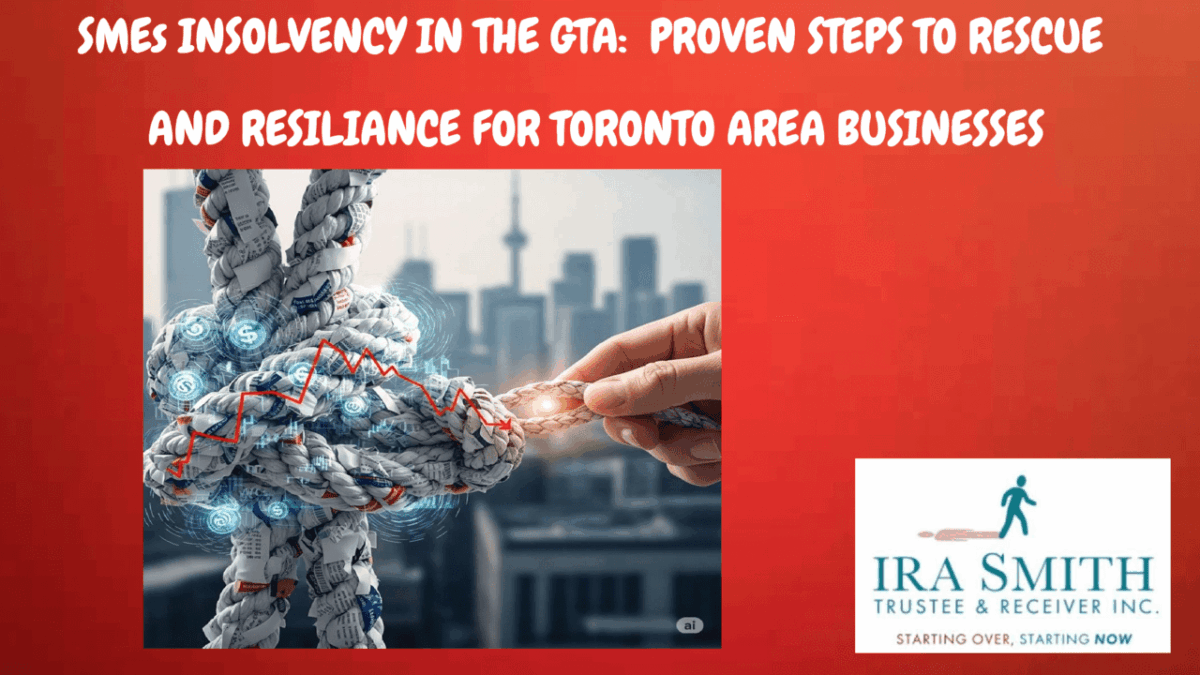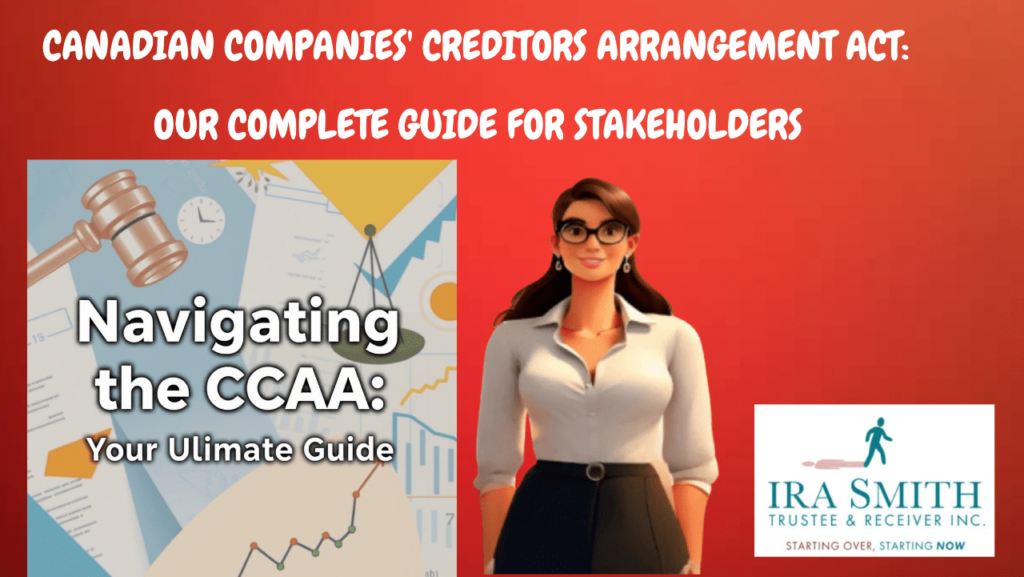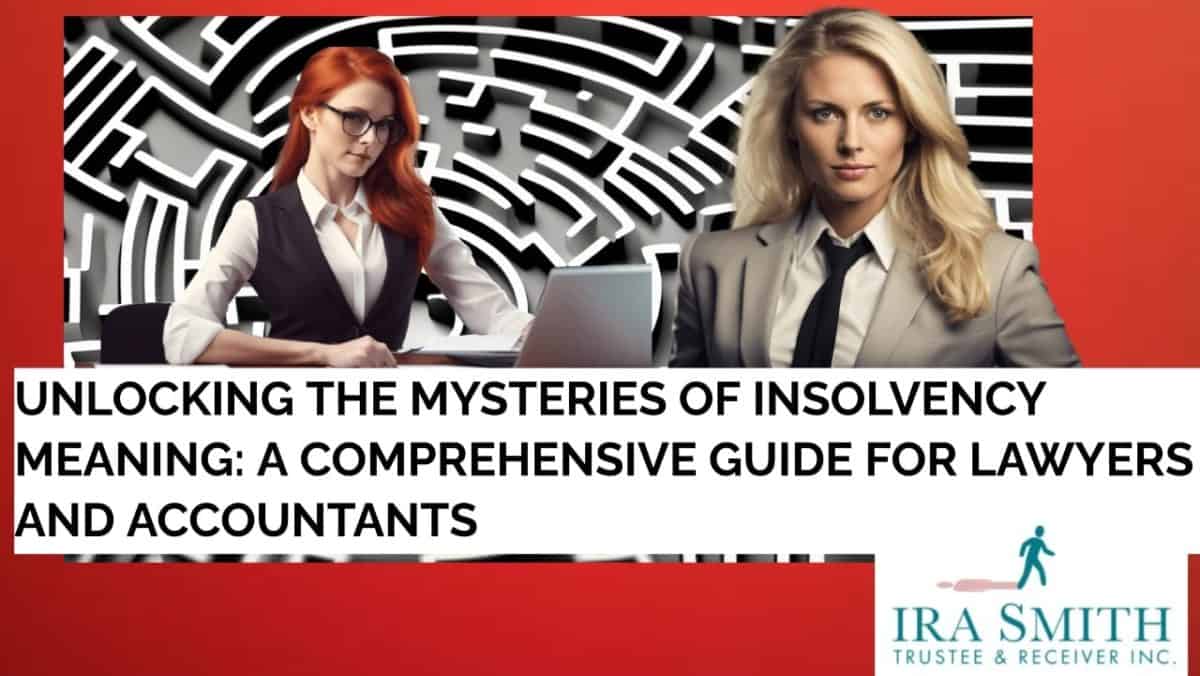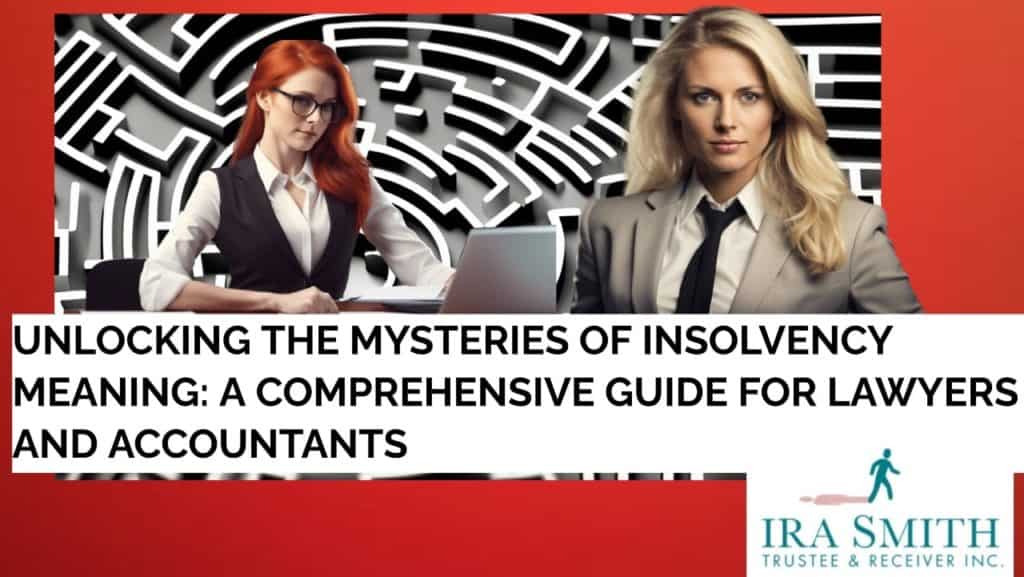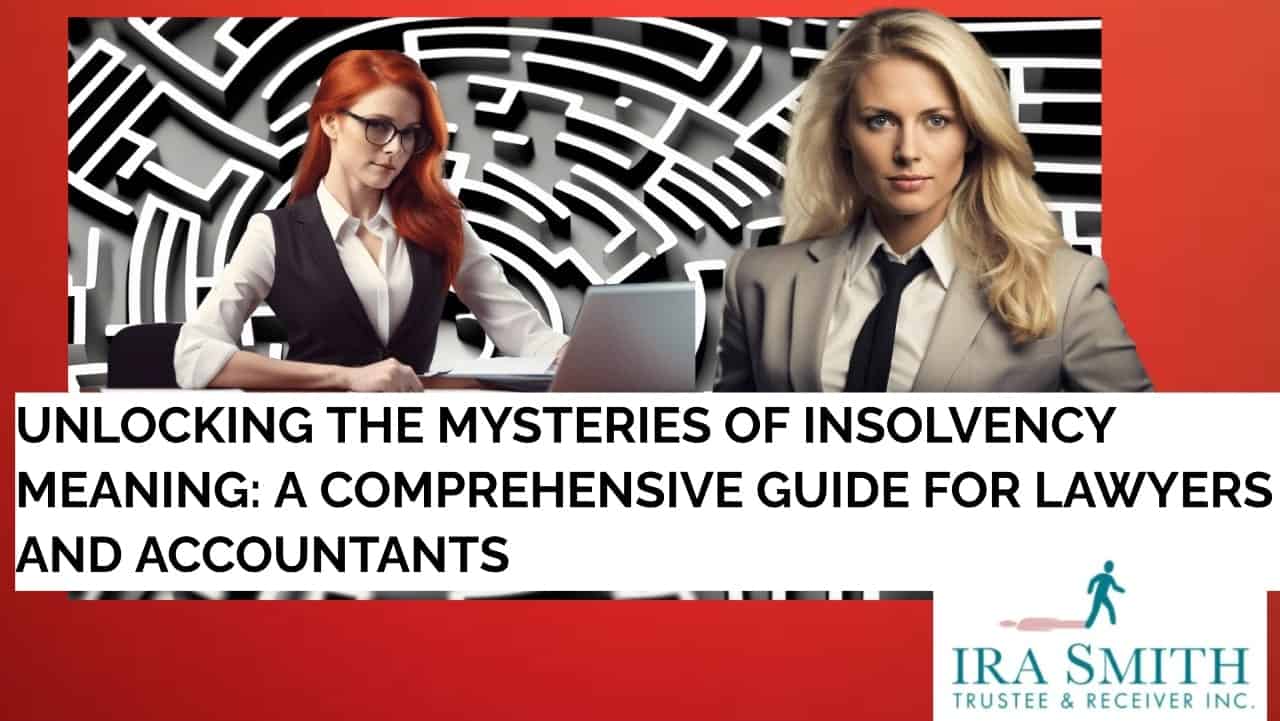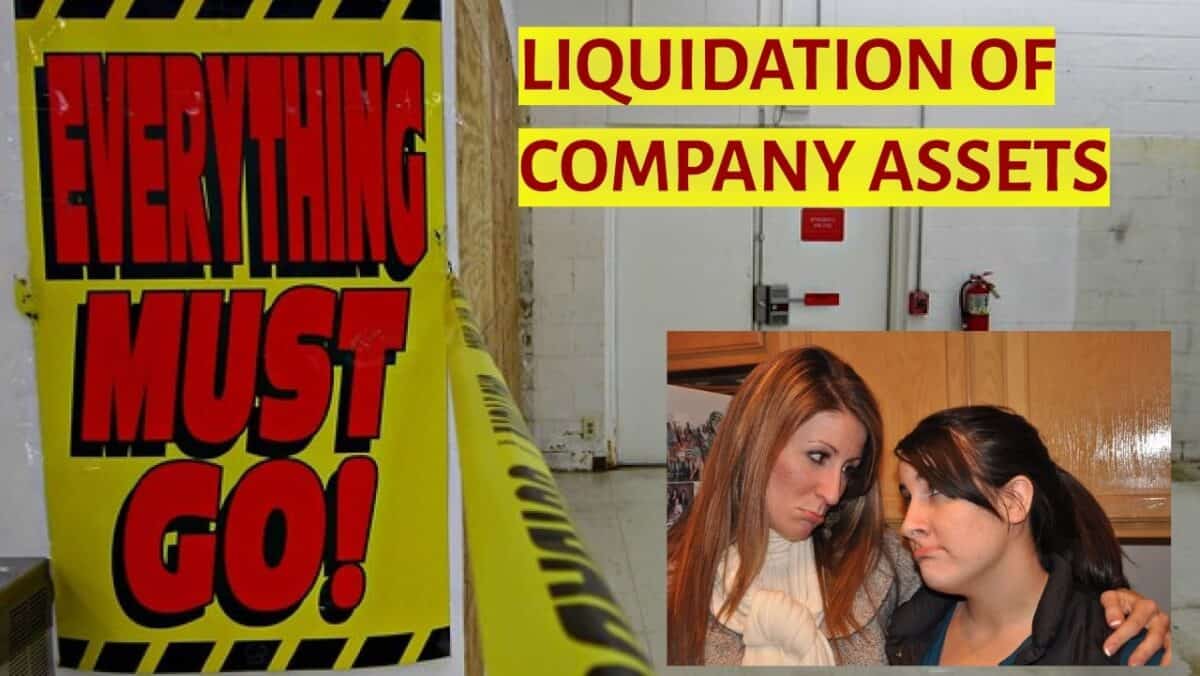Running small and medium enterprises (SMEs) in the Greater Toronto Area has never been easy. However, many business owners are currently facing some of the toughest challenges in decades. Rising costs, changing customer habits, troubling macroeconomic variables and supply chain problems are putting serious pressure on companies across the GTA.
If you’re a business owner struggling to keep up with bills or watching your debt pile up, you’re not alone. More importantly, you have options that can help save your business and protect your employees’ jobs.
As a Licensed Insolvency Trustee firm that has worked with many GTA businesses over the past decades, we’ve seen companies bounce back from what seemed like impossible situations. This Brandon’s Blog will show you the warning signs to watch for, the steps you can take to protect your business, and when to seek professional help.
What Are SMEs and Why Do They Matter to the GTA?
SMEs are the backbone of Ontario’s economy. In Canada, we define these businesses by how many people they employ:
- Small businesses: 1 to 99 employees
- Medium-sized businesses: 100 to 499 employees
- Large businesses: 500 or more employees
SMEs make up over 99% of all businesses in Ontario. In the GTA alone, these companies employ more than 2.5 million people. They run the restaurants where we eat, the shops where we buy clothes, the tech companies building new apps, and the manufacturing plants making products we use every day.
When SMEs struggle, entire communities feel the impact. That’s why helping these businesses survive tough times isn’t just good for individual owners – it’s essential for keeping the GTA economy strong.
The Perfect Storm: Why 2025 Is Especially Tough for GTA Businesses
Several factors are hitting GTA businesses at the same time, creating what experts call a “perfect storm” of challenges.
Rising Operating Costs
Everything costs more now. Rent in the GTA has jumped significantly over the past few years. A small retail space in downtown Toronto that cost $3,000 per month in 2022 might now cost $4,200 or more. Manufacturing businesses are paying 25-30% more for raw materials compared to two years ago.
Labour costs are also climbing. While this is good news for workers, it puts pressure on business owners who are already stretched thin. Many SMEs in the service sector have had to increase wages to attract and keep good employees.
Supply Chain Disruptions
Getting products and materials has become a major headache. A restaurant owner in Mississauga recently told me it now takes three weeks to get equipment parts that used to arrive in three days. A clothing retailer in North York said some of their popular items are backordered for months.
These delays caused by macroeconomic variables don’t just frustrate customers – they tie up cash that businesses need for other expenses. When you have to pay for inventory weeks before you can sell it, cash flow becomes a serious problem.
Changing Consumer Behaviour
Customers are spending differently than they did before. Some are more price-sensitive and shop around more. Others want everything delivered or available online. Many prefer to buy locally but expect the same convenience they get from big retailers.
For SMEs, adapting to these consumer behaviour changes while managing tight budgets is extremely challenging. A family-owned hardware store might need to build an e-commerce website and offer delivery – investments that strain already limited resources.
Economic Uncertainty
Monetary policy decisions, trying to deal with inflation, interest rate changes, a cost-of-living crisis and global trade tensions, create an uncertain business environment. This makes it harder for business owners to plan and make smart financial decisions.
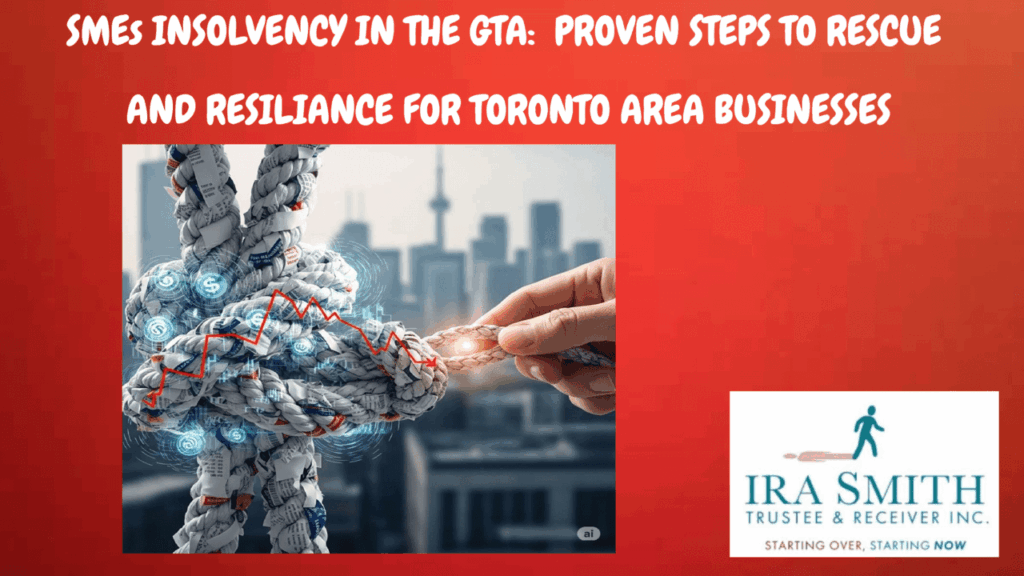
The Numbers Don’t Lie: Insolvency Trends in the GTA
Warning indicators show that business insolvencies in the GTA climbed from 0.4 per 1,000 businesses in 2021 to 0.7 in 2023. While that sounds small, it represents hundreds of local businesses closing their doors because of the business debt crisis.
The sectors seeing the most trouble include:
- Retail businesses (especially small independent stores)
- Restaurants and food services
- Manufacturing companies with fewer than 50 employees
- Construction and renovation companies
- Personal services (salons, fitness centers, etc.)
But here’s what’s important: many of these businesses could have been saved with earlier intervention. In my practice, I’ve found that companies that seek help when they first notice problems have a much better chance of survival than those that wait until they’re facing bankruptcy.
Red Flags: Early Warning Signs Your Business Needs Help
Recognizing financial problems early gives you more options to fix them. Here are the warning signs I tell every business owner to watch for:
Cash Flow Problems
- You’re consistently late paying suppliers or employees
- You’re using credit cards or credit lines to pay basic operating expenses
- You’re borrowing from one creditor to pay another
- Your bank account balance stays low or goes negative regularly
Declining Performance
- Sales have dropped for three months in a row
- Profit margins are shrinking even when sales stay steady
- You’re losing customers to competitors
- Key employees are leaving for better opportunities
Operational Struggles
- You can’t get trade credit from suppliers and they’re demanding cash upfront
- Equipment is breaking down, and you can’t afford repairs
- You’re behind on rent, utilities, or loan payments
- Tax remittances are late or missed entirely
Personal Stress Indicators
- You’re losing sleep worrying about the business
- You avoid looking at financial reports
- You’re using personal credit cards for business expenses
- Family relationships are suffering due to business stress
If you’re experiencing several of these warning signs, it’s time to take action. The good news is that acknowledging problems is the first step toward solving them.

Your Options: What Licensed Insolvency Trustees Can Do for SMEs
Many business owners think that calling a Licensed Insolvency Trustee means their company is finished. That’s not true. We have several tools that can help businesses recover and thrive.
Business Debt Solutions
Informal Arrangements: Sometimes the best solution is working directly with creditors to create payment plans everyone can live with. I’ve helped businesses negotiate extended payment terms, reduced interest rates, or even partial debt forgiveness.
Division I Proposals Under the Bankruptcy and Insolvency Act: This legal process allows businesses to offer creditors a portion of what they owe in exchange for debt forgiveness. For example, a company owing $200,000 might propose to pay $60,000 over three years, with the remaining debt eliminated.
For larger SMEs, this process can restructure significant debt while allowing the business to keep operating. The company presents a plan to creditors for reducing debt and improving operations.
Asset Protection Strategies
We can help protect valuable business assets during financial difficulties. This might include:
- Separating personal and business assets
- Restructuring how the business owns property or equipment
- Creating payment priorities that protect essential operations
Cash Flow Management
Licensed Insolvency Trustees don’t just handle debt – we also provide practical advice on managing money better. This includes:
- Creating realistic budgets and forecasts
- Identifying unnecessary expenses to cut
- Improving collection of accounts receivable
- Negotiating better terms with suppliers
Real SMEs Success Stories from GTA Businesses
Let me share some examples of how early intervention saved local businesses. (Names and details have been changed to protect privacy.)
The Family Restaurant That Survived the COVID-19 Crisis
Maria and Giuseppe owned a popular Italian restaurant in Toronto. When the pandemic hit, their revenue dropped by 75%. They owed $85,000 to suppliers, were three months behind on rent, and had maxed out their credit lines.
Instead of giving up, they contacted us. We worked with their landlord to defer rent payments and negotiated payment plans with key suppliers. We also helped them apply for government relief programs they didn’t know existed.
Today, their restaurant is thriving again. They’ve paid off most of their pandemic debt and even opened a second location in Vaughan.
The Tech Company That Restructured
This company employed 35 people in developing cutting-edge technology solutions for managing business operations for companies. When their biggest customer cancelled a major contract, they faced $450,000 in debt they couldn’t pay.
We helped them file a Division I Proposal that reduced their debt to $95,000, payable over four years. This gave them breathing room to find new customers and improve their operations. They also worked on diversifying their customer base to reduce future risk.
Two years later, the company has grown and is more profitable than before their financial crisis.

Building a Stronger Business: Practical Steps for SME Owners
Whether your business is struggling now or you want to prepare for future challenges, these strategies can help build resilience:
Improve Financial Management
Track Everything: Use accounting software to monitor your finances daily, not just when tax time comes around. Many problems become obvious when you look at the financial ratios and other important numbers regularly.
Create Cash Flow Forecasts: Predict your income and expenses for the next 6-12 months. This helps you spot potential problems before they become crises.
Separate Business and Personal Finances: Never mix business and personal expenses. This creates confusion and can cause serious legal problems if your business faces insolvency.
Diversify Your Revenue
Find New Customers: Don’t rely too heavily on one or two big customers. If you lose them, your entire business could be at risk.
Add New Products or Services: Look for ways to serve your existing customers better or attract new ones. A plumbing company might add drain cleaning services. A bakery might start catering events.
Explore Online Sales: Even if you’re primarily a brick-and-mortar business, having an online presence can help you reach more customers and provide additional revenue during slow periods.
Strengthen Supplier Relationships
Pay Bills on Time: Good relationships with suppliers can be a lifeline during tough times. Companies that consistently pay promptly often get better terms and more flexibility when needed.
Diversify Suppliers: Don’t depend on just one supplier for critical materials or products. Having backup options protects you from supply chain disruptions.
Negotiate Better Terms: Ask for extended payment terms, volume discounts, or seasonal adjustments that match your cash flow patterns.
Invest in Your Team
Cross-Train Employees: Make sure multiple people can handle essential tasks. This reduces the risk of operational problems when key employees leave.
Focus on Customer Service: Excellent service helps you keep customers even when competitors offer lower prices.
Plan for Succession: Have a plan for what happens if you become unable to run the business due to illness, injury, or other circumstances.
When A SME Should Call a Licensed Insolvency Trustee
Don’t wait until you’re facing bankruptcy to seek professional help. Consider calling a Licensed Insolvency Trustee if:
- You’re using credit to pay operating expenses
- You’re behind on tax payments or employee wages
- Suppliers are demanding cash payments up front
- You’re considering borrowing against personal assets to keep the business running
- You’re losing sleep worrying about money
What to Expect from Your First Consultation
Most Licensed Insolvency Trustees offer free initial consultations. Here’s what typically happens:
Financial Review: We’ll look at your debts, assets, cash flow, and overall financial situation. Bring recent financial statements, a list of creditors, and any legal documents you’ve received.
Options Discussion: We’ll explain all available options, not just insolvency procedures. This might include debt negotiation, restructuring, or operational changes.
Action Plan: If you decide to work together, we’ll create a specific plan with clear steps and timelines.
Ongoing Support: We provide ongoing advice and support throughout the recovery process.

The Importance of Acting Early For SMEs
I can’t stress this enough: the earlier you seek help, the more options you have. Businesses that wait until they’re facing immediate closure have fewer alternatives and often face more expensive solutions.
Early intervention can:
- Preserve more jobs
- Maintain better relationships with suppliers and customers
- Protect personal assets
- Reduce stress on you and your family
- Increase the chances of business survival
Your Next SME Steps
If you’re a SME owner in the GTA facing financial challenges, don’t wait for things to get worse. Here’s what you should do:
- Assess Your Situation Honestly: Look at your financial statements and identify specific problems. Write down your concerns and questions.
- Gather Your Financial Information: Collect recent financial statements, tax returns, creditor lists, and any legal documents you’ve received.
- Contact a Licensed Insolvency Trustee: Schedule a consultation to discuss your options. Most initial meetings are free and confidential.
- Explore All Options: Don’t assume bankruptcy is your only choice. Many businesses can be saved with the right intervention.
- Take Action: Once you understand your options, implement a plan quickly. Delaying action usually makes problems worse.

sme
Frequently Asked Questions About SME Insolvency in the GTA
What exactly counts as an SME in Ontario?
In Canada, we classify businesses by how many people work for them. A small business has between 1 and 99 employees, while a medium-sized business employs 100 to 499 people. Companies with 500 or more workers are considered large enterprises.
This might seem like just paperwork, but it matters a lot. SMEs make up over 99% of all businesses in Ontario. In the GTA, they employ more than 2.5 million people. These are the companies you interact with every day – your local coffee shop, the accounting firm down the street, the manufacturing plant in your neighbourhood. When SMEs struggle, entire communities feel the impact.
Why are GTA businesses facing so many problems right now?
Several big challenges are hitting local businesses at the same time. Think of it like a perfect storm where everything goes wrong together.
First, costs keep going up. A small store in downtown Toronto that paid $3,000 monthly rent in 2020 might now pay over $4,000. Manufacturing businesses are paying 25-30% more for raw materials than they did two years ago.
Second, getting supplies has become a nightmare. A restaurant owner in Mississauga told me equipment parts that used to arrive in three days now take three weeks. This ties up money that businesses need for other things.
Third, customers are shopping differently. They want online ordering, fast delivery, and competitive prices. For a small business, adding these services while managing tight budgets is extremely tough.
Finally, everything feels uncertain. Interest rates, inflation, and global trade issues make it hard for business owners to plan ahead confidently.
How can I tell if my GTA business is in financial trouble?
Watch for these warning signs that I see in businesses before they call my office:
Money problems: You’re consistently late paying suppliers or staff. You’re using credit cards to cover basic expenses like rent or utilities. Your bank account stays low or goes negative regularly.
Declining sales: Revenue has dropped for three months straight. You’re losing customers to competitors. Profit margins are shrinking even when sales stay the same.
Operational issues: Suppliers want cash upfront instead of giving you credit terms. Equipment breaks down, and you can’t afford repairs. You’re behind on rent, loan payments, or tax remittances.
Personal stress: You’re losing sleep worrying about money. You avoid looking at financial reports because they’re too depressing. You’re using personal credit cards for business expenses.
If several of these sound familiar, it’s time to get professional help. The good news is that recognizing problems early gives you more options to fix them.
What can a Licensed Insolvency Trustee do for my business?
Many business owners think calling me means their company is finished. That’s completely wrong. I have several tools that can help businesses recover and even grow stronger.
Debt solutions: I can work with your creditors to create payment plans everyone can accept. Sometimes this means extending payment terms, reducing interest rates, or even getting partial debt forgiveness. For larger debts, we might use formal proposals under bankruptcy law that legally reduce what you owe.
Asset protection: I help separate your personal and business assets so your family home isn’t at risk if the business struggles. We can also restructure how your company owns equipment or property to better protect valuable assets.
Cash flow help: Beyond handling debt, I provide practical advice on managing money better. This includes creating realistic budgets, identifying expenses to cut, improving how you collect money from customers, and negotiating better terms with suppliers.
The key is getting help early when you have more options available.
What steps can I take right now to protect my SME business?
Whether your business is struggling or you want to prepare for future challenges, these strategies help build strength:
Get your finances organized: Use accounting software to track money daily, not just at tax time. Create cash flow forecasts for the next 6-12 months to spot problems early. Never mix business and personal expenses – this creates confusion and legal problems.
Don’t put all your eggs in one basket: Find new customers so you’re not too dependent on one or two big accounts. Add new products or services that serve your existing customers better. Even traditional businesses benefit from having some online presence.
Build strong supplier relationships: Pay bills on time to maintain good relationships. Have backup suppliers for critical materials. Negotiate payment terms that match your cash flow patterns.
Invest in your team: Cross-train employees so multiple people can handle essential tasks. Focus on excellent customer service to keep customers even when competitors offer lower prices. Have a plan for what happens if you can’t run the business due to illness or other circumstances.
When should I call a Licensed Insolvency Trustee for help?
Don’t wait until you’re facing bankruptcy. Contact a professional if:
- You’re using credit to pay basic operating expenses
- You’re behind on tax payments or employee wages
- Suppliers are demanding cash payments instead of giving you credit
- You’re thinking about borrowing against your house to keep the business running
- You’re losing sleep worrying about money problems
The earlier you get help, the more options you have. Businesses that wait until the last minute often face more expensive solutions with fewer choices.
What happens during my first meeting with you?
Most Licensed Insolvency Trustees, including myself, offer free initial consultations. Here’s what typically happens:
We review your finances: I’ll look at your debts, assets, cash flow, and overall financial situation. Bring recent financial statements, a list of who you owe money to, and any legal documents you’ve received.
We discuss all your options: I’ll explain everything available to you, not just bankruptcy procedures. This might include debt negotiation, business restructuring, or operational changes that could solve your problems.
We create an action plan: If you decide to work together, we’ll make a specific plan with clear steps and realistic timelines.
You get ongoing support: I don’t just file paperwork and disappear. Many trustees provide advice and support throughout your recovery process.
Everything we discuss is completely confidential. My job is to find the best path forward for your specific situation.
How much does it cost to work with a Licensed Insolvency Trustee?
The first consultation is always free. For ongoing services, costs depend on what your business needs. Generally, we bill based on hourly fees. Formal proposals under bankruptcy law have to be approved by the court. More often than not, it is paid from money you would have paid to creditors anyway.
Many business owners are surprised to learn that professional help often costs less than continuing to struggle alone. When we successfully reduce your debt or improve your cash flow, the savings usually far exceed any fees. The fees are even more reasonable when the restructuring Proposal calls for your unsecured creditors to pay the fees for your SME restructuring!
I always explain all costs upfront so there are no surprises. The goal is to help your business become profitable again, not add to your financial burden.
Why is acting quickly so important for GTA businesses?
I can’t stress this enough: the sooner you seek help, the more we can do for your business. Companies that contact me when they first notice problems have many more options than those who wait until they’re facing immediate closure.
Early action can:
- Save more jobs for your employees
- Preserve better relationships with suppliers and customers
- Protect your personal assets like your family home
- Reduce stress on you and your family
- Dramatically increase your chances of business survival

sme
Final SME Thoughts
Running a SME business in the GTA isn’t easy, but thousands of SME owners successfully navigate financial challenges every year. The key is recognizing problems early and getting professional help when you need it.
As a Licensed Insolvency Trustee with extensive experience helping GTA SME businesses, I’ve seen companies recover from seemingly impossible situations. With the right approach, your business can not only survive current challenges but also emerge stronger and more profitable.
Remember, seeking help isn’t a sign of failure – it’s a smart business decision that can save your company, protect your employees’ jobs, and preserve your investment in your business.
If you’re ready to take the next step, contact a Licensed Insolvency Trustee today. Your business and your peace of mind are worth the phone call.
If your business is facing financial challenges, don’t wait until it’s too late. Early intervention provides more options and better outcomes. Contact Ira Smith Trustee & Receiver Inc. today to discuss your situation confidentially and explore your options.
You’re not alone in this. There’s a path forward, and it starts with reaching out for the right kind of help. Take that step—you deserve it. If you’re a GTA resident dealing with an overwhelming debt crisis, don’t wait for your credit situation to get worse. As a licensed insolvency trustee serving Toronto, Mississauga, Brampton, Markham, and surrounding areas, I’m here to help you understand your options.
Free consultation available:
- No obligation to proceed
- Complete review of your Canadian business debt and credit situation
- Practical next steps you can take immediately
Remember: Your current financial situation doesn’t define your future. With the right help and information, you can overcome both a debt crisis and credit score problems.
As a licensed insolvency trustee in the Greater Toronto Area, I tell consumers and business owners to see financial problems not as failures but as challenges. Proper guidance can solve them. By knowing the warning signs of insolvency and getting professional advice early, many people and businesses find a way forward. They can restructure, make strategic changes, or wind down in an orderly way that protects future chances.
Remember: The earlier you seek help for company insolvency concerns, the more options you’ll have.
If you or someone you know is struggling with too much debt, remember that the financial restructuring process, while complex, offers viable solutions with the right guidance. As a licensed insolvency trustee serving the Greater Toronto Area, I help Canadian entrepreneurs understand their options and find a path forward during financial challenges.
At the Ira Smith Team, we understand the financial and emotional components of a debt crisis. We’ve seen how traditional approaches often fall short in today’s economic environment, so we focus on modern debt relief options that can help you avoid bankruptcy while still achieving financial freedom.
The stress of financial challenges can be overwhelming. We take the time to understand your unique situation and develop customized strategies that address both your financial needs and emotional well-being. There’s no “one-size-fits-all” approach here—your financial solution should be as unique as the challenges you’re facing.
If any of this sounds familiar and you’re serious about finding a solution, reach out to the Ira Smith Trustee & Receiver Inc. team today for a free consultation. We’re committed to helping you or your Canadian company get back on the road to healthy, stress-free operations and recover from financial difficulties. Starting Over, Starting Now.
The information provided in this blog is intended for educational purposes only. It is not intended to constitute legal, financial, or professional advice. Readers are encouraged to seek professional advice regarding their specific situations. The content should not be relied upon as a substitute for professional guidance or consultation. The author, Ira Smith Trustee & Receiver Inc., and any contributors do not assume any liability for any loss or damage.


